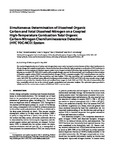Simultaneous determination of dissolved organic carbon and total dissolved nitrogen on a coupled high-temperature combustion total organic carbon-nitrogen chemiluminescence detection (HTC TOC-NCD) system
| dc.contributor.author | Pan, X | |
| dc.contributor.author | Sanders, R | |
| dc.contributor.author | Tappin, Alan | |
| dc.contributor.author | Worsfold, Paul | |
| dc.contributor.author | Achterberg, EP | |
| dc.date.accessioned | 2017-05-11T07:57:28Z | |
| dc.date.available | 2017-05-11T07:57:28Z | |
| dc.date.issued | 2005-08-01 | |
| dc.identifier.issn | 1463-9246 | |
| dc.identifier.issn | 1464-5068 | |
| dc.identifier.uri | http://hdl.handle.net/10026.1/9227 | |
| dc.description.abstract |
The marine biogeochemistries of carbon and nitrogen have come under increased scrutiny because of their close involvement in climate change and coastal eutrophication. Recent studies have shown that the high-temperature combustion (HTC) technique is suitable for routine analyses of dissolved organic matter due to its good oxidation efficiency, high sensitivity, and precision. In our laboratory, a coupled HTC TOC-NCD system with a sample changer was used for the automated and simultaneous determination of dissolved organic carbon (DOC) and total dissolved nitrogen (TDN) in seawater samples. TOC control software was used for TOC instrument control, DOC data acquisition, and data analysis. TDN data acquisition and manipulation was undertaken under LabVIEW. The combined system allowed simultaneous determination of DOC and TDN in the same sample using a single injection and provided low detection limits and excellent linear ranges for both DOC and TDN. The risk of contamination has been remarkably reduced due to the minimal sample manipulation and automated analyses. The optimised system provided a reliable tool for the routine determination of DOC and TDN in marine waters. | |
| dc.format.extent | 240-246 | |
| dc.format.medium | ||
| dc.language | en | |
| dc.language.iso | en | |
| dc.publisher | Hindawi Limited | |
| dc.subject | 14 Life Below Water | |
| dc.title | Simultaneous determination of dissolved organic carbon and total dissolved nitrogen on a coupled high-temperature combustion total organic carbon-nitrogen chemiluminescence detection (HTC TOC-NCD) system | |
| dc.type | journal-article | |
| dc.type | Journal Article | |
| plymouth.author-url | https://www.webofscience.com/api/gateway?GWVersion=2&SrcApp=PARTNER_APP&SrcAuth=LinksAMR&KeyUT=WOS:000235925600006&DestLinkType=FullRecord&DestApp=ALL_WOS&UsrCustomerID=11bb513d99f797142bcfeffcc58ea008 | |
| plymouth.issue | 4 | |
| plymouth.volume | 2005 | |
| plymouth.publication-status | Published | |
| plymouth.journal | Journal of Automated Methods & Management in Chemistry | |
| dc.identifier.doi | 10.1155/jammc.2005.240 | |
| plymouth.organisational-group | /Plymouth | |
| plymouth.organisational-group | /Plymouth/Faculty of Science and Engineering | |
| plymouth.organisational-group | /Plymouth/REF 2021 Researchers by UoA | |
| plymouth.organisational-group | /Plymouth/REF 2021 Researchers by UoA/UoA07 Earth Systems and Environmental Sciences | |
| plymouth.organisational-group | /Plymouth/Research Groups | |
| plymouth.organisational-group | /Plymouth/Research Groups/BEACh | |
| plymouth.organisational-group | /Plymouth/Research Groups/Marine Institute | |
| plymouth.organisational-group | /Plymouth/Users by role | |
| dc.publisher.place | United States | |
| dcterms.dateAccepted | 2005-05-12 | |
| dc.identifier.eissn | 1464-5068 | |
| dc.rights.embargoperiod | Not known | |
| rioxxterms.versionofrecord | 10.1155/jammc.2005.240 | |
| rioxxterms.licenseref.uri | http://www.rioxx.net/licenses/all-rights-reserved | |
| rioxxterms.type | Journal Article/Review |


